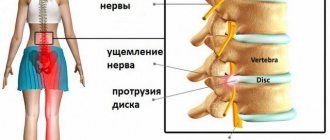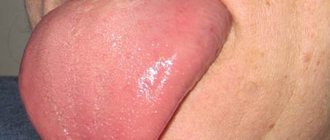4128
If you watch small children, you will see how some of them often stick out their tongues. Most of the time it's just for fun or exploring your body.
But sometimes such a prank is an indicator of an abnormality in the development of the language, namely macroglossia. Unfortunately, this disease occurs not only in children, but also in adults. And its untimely treatment leads to serious consequences.
In today’s article we will find out why a person’s tongue can be enlarged, what diagnosis is made in this case, and how to get rid of this disease.
Forms
Photo: macroglossia
According to the different nature of the causes of this disease, medicine distinguishes its two forms: local or local, and generalized. Local (local) macroglossia occurs as a result of improper development of the circulatory system, which has no connection with general diseases of the body that lead to hypertrophy of the tongue.
Most often, this form occurs due to vascular formations of the tongue - lymphangioma or hemlymphangioma. The main location is the front part, but sometimes it is also observed on the root. Local macroglossia is typical for children of the first years of life
.
When additional infections and diseases occur, the tongue rapidly enlarges.
The generalized form of macroglossia occurs due to concomitant pathologies of the whole organism. For example, hemihypertrophy, hypothyroidism, Beckwith-Wiedemann syndrome. Characterized by enlargement of the tongue on one or both sides.
Standard Treatments
Treatment and prognosis for macroglossia depend on its cause, as well as the severity of tongue enlargement and the symptoms it causes. Mild cases or cases with minimal symptoms may not require treatment. Speech therapy or surgery to reduce the size of the tongue (glossectomy) may be helpful. Treatment may also include correction of orthodontic problems that may be caused by an enlarged tongue. Treatment of any underlying systemic disease, such as radiation therapy, may be required.
Causes
For acquired and congenital macroglossia, the causes differ and are conventionally divided into two groups.
Congenital macroglossia
- benign tumor-type formation. Occurs as a result of a violation of the proper development of the fetus;
- hypertrophy of the muscular apparatus of the tongue, accompanied by idiopathic diseases;
- exposure to harmful factors on the pregnant woman’s body: severe infectious diseases, radiation, regular alcohol intoxication. In this case, the fetus experiences active growth of only one half of the face;
- the formation of a cyst or cavity during the formation of the muscular apparatus of the tongue.
Acquired macroglossia
- improper functioning of the thyroid gland, which leads to insufficient production of its hormones. This in turn causes physical and mental retardation;
- excessive production of a hormone responsible for human growth. Observed in older people;
- complete loss of lower jaw teeth;
- amyloidosis. Excessive accumulation of carbohydrate and protein compounds;
- malignant tumors;
- syphilis;
- tuberculosis;
- the presence of purulent inflammation;
- profuse intramuscular hemorrhage;
- pathologies caused by fungal infections (candidiasis);
- disruption of lymph flow and blood flow;
- allergic reaction
- catarrhal glossitis.
Let's find out what causes the yellow coating on a person's tongue.
In this article, read reviews about ultrasonic teeth cleaning.
Here: https://www.vash-dentist.ru/lechenie/yazyik-l/prichinyi-poyavleniya-naleta-korichnevogo-tsveta.html - let’s figure out why a brown coating may appear on the tongue.
Causes of macroglossia
Most often, the cause of the development of anomalies is congenital pathologies. Thus, the cause of the problem in newborns may be a benign neoplasm that began to grow at the stage of intrauterine development of the fetus, or an idiopathic disease with muscular hypertrophy of the tongue. Other possible prerequisites, dental experts include, are negative influences and conditions during pregnancy, acute infections, radiation exposure, alcohol poisoning, and hereditary factors. Experts also identify a number of genetic disorders, including the formation of cysts in the oral cavity during the formation of the tongue muscles1.
Read more about childhood tongue diseases in our special article>>>
“By the way, I also had no idea about this disease until a work colleague encountered something similar. As far as I understand, something went wrong during pregnancy, and the child was diagnosed with a congenital cyst on the tongue. I had to undergo surgery, and rehabilitation was not easy. It seems like everything is fine with the baby now...”
Kim7, Izhevsk, from correspondence on the woman.ru forum
As for adult patients, in this case macroglossia can result from the following phenomena and processes:
- malfunction of the thyroid gland, hormonal disorders,
- absence of all teeth in the mouth - complete edentia,
- open bite,
- amyloidosis – a disorder of protein metabolism,
- glycogenosis – disorders of the synthesis and breakdown of glycogen,
- pellagra is one of the forms of vitamin deficiency,
- rhinoscleroma – formation of nodules on the mucous membrane of the oral cavity and nasopharynx,
- syphilis, tuberculosis,
- neoplasms of both benign and malignant nature,
- inflammatory processes accompanied by the formation of pus,
- angioedema in acute form,
- “flaccid” tongue syndrome, characteristic of neurological disorders,
- intramuscular hemorrhage,
- candidiasis (fungal infections),
- malfunctions of the hematopoietic system,
- catarrhal glossitis.
There can be many causes of the pathology.
Sometimes a severe allergic reaction can provoke the problem. Also in medical practice, there are cases when the patient’s overweight becomes a prerequisite for pathology.
Symptoms
In everyday life, experts come across such concepts as false and true macroglossia. The fact is that incorrect development of the jaw arch is often mistaken for an increase in the muscular system of the tongue.
.
With a narrow or receding jaw, a tongue of standard length and width appears more voluminous. In such cases, macroglossia is false. In the case when the tongue actually has an enlargement that exceeds its normal size by one and a half times, then this is true macroglossia.
In newborns
The success of treating this disease depends on timely detection of symptoms. The congenital form must be detected in a newborn child, without waiting for him to grow up. This will avoid the chronic course of the pathology.
Certain symptoms have been identified for this:
- visible enlargement of the tongue with a protrusion outside the oral cavity;
- the surface of the tongue is dried out and becomes “varnished”;
- labored breathing;
- refusal to eat, as the enlarged root of the tongue blocks the larynx;
- regular attacks of asphyxia;
- pronounced surface roughness;
- papillary hypertrophy;
- slightly open mouth position (all or most of the time);
- increased salivation;
- body temperature rises, since in the case of macroglossia additional infections are often associated;
- There is a deterioration in the general condition of the child.
Chronic macroglossia
These symptoms are more related to the severe or chronic form of macroglossia and mainly serve to determine the disease in an adult.
These symptoms include:
- enlargement of the tongue by half its size or more;
- the mouth is constantly in an open position;
- there is copious secretion of saliva;
- the surface of the tongue becomes rough;
- cracks appear that often bleed;
- tongue mobility is almost completely limited;
- on the tongue there are bluish bubbles filled with blood from capillary vessels;
- speech dysfunction;
- regular injury to the mucous membranes and tongue with crowns;
- severe lymphangioma in the lower part of the mouth or neck.
Signs and symptoms
Macroglossia is a condition characterized by a larger tongue compared to other structures in the mouth. In the congenital type of the disorder, tongue protrusion from the mouth can interfere with the baby's feeding. Later, it may interfere with the conversation. A large tongue can also cause abnormal development of the jaw and teeth, causing teeth to shift or protrude. Ulcerations and tissue death on the tip of the tongue may be other symptoms of the disorder.
All major signs and symptoms include:
- shortness of breath—difficulty, noisy breathing, obstructive sleep apnea, or airway obstruction;
- dysphagia - difficulties with swallowing and eating;
- dysphonia - impaired speech, possibly manifesting as a whisper;
- sialorrhea - salivation;
- angular cheilitis—ulcers in the corners of the mouth;
- scalloped tongue - indentations on the lateral borders of the tongue caused by pressure from the teeth;
- open bite - a type of dental bite;
- mandibular prognathism - expansion of the lower jaw;
- breathing through the mouth;
- orthodontic disorders, including diastema and spacing between teeth.
A tongue that constantly protrudes from the mouth is susceptible to drying out, ulceration, infection, or even necrosis.
Consequences
Macroglossia is a phenomenon that brings not only temporary inconvenience, but can also have serious consequences, which are extremely dangerous for the body. First of all, the functioning of the entire respiratory system is disrupted
, which leads to its pathologies.
Delayed treatment to the clinic leads to the development of malocclusion
which can only be corrected through complex orthodontic procedures. Their appointment is possible only if macroglossia is successfully eliminated.
With macroglossia, the installation and use of any orthodontic systems is impossible.
In addition to the listed consequences, deformation of dental and periodontal tissues occurs. The functioning of the digestive system and alimentary tract is also
.
Gastritis, ulcers, colitis appear
etc.
Partial speech impairment
. This is especially reflected in the pronunciation of whistling and hissing sounds.
If left untreated, the disease progresses and is constantly accompanied by pain, as regular inflammation of the mucous membrane and tongue biting occurs. At a minimum, this disease causes problems of a social nature, and appearance is to blame.
Complications
Often patients do not consider the disease too serious, especially at its early stages, and do not seek treatment at the clinic. It’s a pity, because if you don’t try to eliminate the pathology, the consequences can be more serious than it seems at first glance.
Such frivolity can cause a whole “bouquet” of unpleasant surprises:
- failure of respiratory function , forming the incorrect habit of breathing with an open mouth;
- disruption of the speech apparatus - it becomes almost impossible to pronounce hissing sounds. In this case, diction becomes incomprehensible, the patient begins to develop psychological complexes of his own inferiority, and isolation appears;
- problems with the condition of the dentition , accompanied by improper growth of teeth, their loosening and partial atrophy;
- stomach diseases due to inadequate chewing of food.
In addition, at the progression stage, persistent pain occurs, the tongue becomes inflamed, the threshold of its sensitivity increases, in addition, it constantly bites.
Diagnostics
Macroglossia can be diagnosed already during fetal development
. Currently, medicine has developed standard sizes for each fetal organ at any stage of pregnancy. These standards include the length and width of the tongue.
However, experts make a final conclusion only when studying the profile projection of the fetus with an interval of 1–2 months. If at the same time a tongue protruding beyond the oral cavity is detected each time, then a diagnosis of macroglossia is made.
Most often, a diagnosis can be made only closer to 30 weeks of pregnancy, but in rare cases this pathology can be detected as early as 19 weeks.
After birth and throughout life, to diagnose macroglossia, you need to contact an otolaryngologist, who will prescribe a full examination, including clinical tests and instrumental methods.
After identifying the cause of the disease, consultation with other specialists may be necessary: endocrinologist, infectious disease specialist, oncologist, etc. After which a treatment plan is drawn up.
Treatment
Three methods are used to treat macroglossia:
Drug therapy
In case of pathology caused by general diseases, treatment is always aimed at eliminating the cause. For this purpose, a set of drugs is selected, and means are prescribed for regular treatment of the oral cavity and tongue.
Surgery
It is determined individually, in accordance with the diagnosis and the causes of the pathology. To do this, various surgical methods are used, which have their differences:
- Surgical treatment in newborns consists of wedge-shaped or flap resection of the pathological area of the tongue. After this, U-shaped sutures are applied;
- for vascular pathologies, sclerotherapy or phlebectomy is performed. During sclerotherapy, a special drug is injected into the vessels to promote their restoration. During phlebectomy, the affected vessels are excised;
- During the period of active growth of the child, the method of ligating the artery of the tongue is used. This leads to a decrease in growth rates and its gradual restoration in size;
- if there is a shortened frenulum of the tongue, it is cut off from the inner surface.
The procedure for trimming the frenulum of the tongue in children is carried out using a surgical spatula with an anatomical notch, which is used to lift the tongue until the frenulum is fully tensioned. After that, excision is carried out using surgical scissors or a scalpel to a distance of up to 1.5 cm. If the procedure is carried out correctly, blood loss is eliminated, so sutures are not required.
Let's find out why a white coating forms on the tongue, is it dangerous?
This publication describes ways to treat mouth ulcers.
Here: https://www.vash-dentist.ru/lechenie/zubyi/dentofobiya-stomatofobiya-raznovidnosti-i-sposobyi.html - you can find out how to deal with dentophobia.
Complex method
Most often used for tumor formations. Treatment with this method includes:
- excision of the affected part;
- application of the sclerotherapy method;
- drug therapy, which is aimed not only at eliminating the cause, but also at preventing relapse;
- vascular embolization;
- hormonal therapy.
The complex method includes drug therapy and surgery and is the most effective for successfully combating this pathology.
Indications for surgery
Surgical intervention is not indicated in all cases of macroglossia development. Similar methods are used in the presence of certain factors:
- pathological respiratory dysfunction;
- complete disorder of the eating process;
- improper performance of speech function;
- for problems of an aesthetic nature;
- uncontrolled salivation;
- formed open bite. Only if it is impossible to correct an open bite using orthodontic systems.
Always remember that macroglossia is not just an unpleasant phenomenon that spoils a person’s appearance and causes pain. This is a pathology that leads to serious problems and irreversible consequences. Therefore, treatment must be timely and completed in full.
In conclusion, the video “Surgical treatment of macroglossia”:
If you find an error, please select a piece of text and press Ctrl+Enter.
Tags macroglossia language
Did you like the article? stay tuned
Previous article
Osteomyelitis of the jaw: types and methods of treatment
Next article
Plates for teeth straightening: types and nuances of application
Prevention
If the body is prone to this anomaly, the risk of its development can be minimized by performing the following actions:
- control of the muscular state of the organ;
- regular visits to the dentist in order to prevent the occurrence of dental ailments, and if they occur, immediate treatment;
- do not contact people suffering from infectious pathologies;
- monitor the functioning of the thyroid gland and the hormonal state of the body;
- quit smoking and alcohol abuse;
- nutritious food , which should include large quantities of vegetables and fruits, dairy products.
To learn about what macroglossia is and how to treat it surgically, watch the video.








